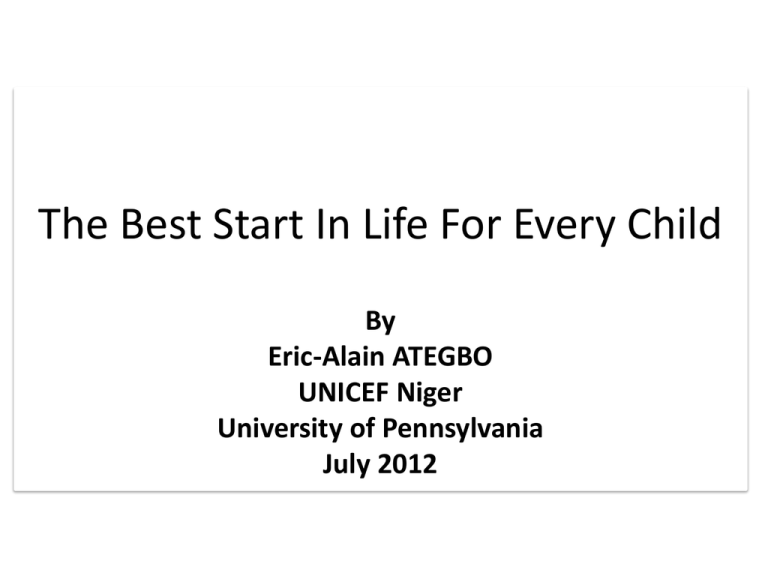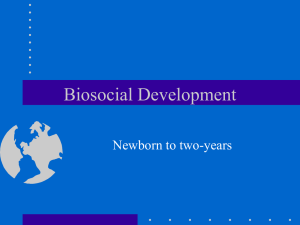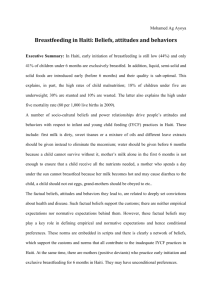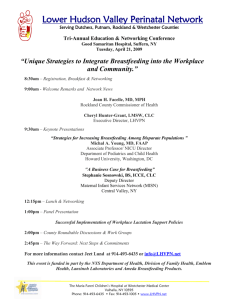Eric-Alain Ategbo
advertisement

The Best Start In Life For Every Child By Eric-Alain ATEGBO UNICEF Niger University of Pennsylvania July 2012 THE CONTEXT • High prevalence of all forms of malnutrition among children. – One in every five children below 2 years is affected by acute malnutrition (high correlation with mortality) – Among children under 5, every other child is stunted (chronic malnutrition) • High prevalence of malnutrition has negative consequences for: – Child survival, growth and development – The development of the community and the country THE CONTEXT (2) A simple and effective technology - Exclusive breastfeeding Exclusive breastfeeding implies: – initiation of breastfeeding within one hour after delivery – breast milk being the sole food and fluid the newborn is raised on, from birth up to six months of age. Except medical advise Exclusive Breastfeeding is the single cost effective intervention with the highest impact on child survival (prevent 13% of under 5 mortality) Despite what we know, unfortunately only 2 in 5 babies worldwide, and 1 in 4 babies in Niger enjoys Exclusive Breastfeeding WHAT DO WE KNOW? Current Beliefs Barriers to exclusive breastfeeding Only weak women required more than one medical checkup during pregnancy. It is a pride to deliver at home in the presence of the mother in law . Colostrum is bad for the newborn, and is thrown away. The baby needs water to survive. Solid foods are required to satisfy the needs of the child. Breast milk of the pregnant mother is a poison. WHAT HAS BEEN DONE SO FAR? • Baby Friendly Hospital Initiative (BFHI) • Celebration of the World BreastFeeding Week • Massive communication campaigns – Mass media – Community based approaches – Interpersonnal technics • Nutrition education, IEC, BCC and now C4D RESULT: In Niger 3 out of 4 children are still denied their right to best start in life WHAT WENT WRONG? • • • • Usually one way communication (prescriptive) Failure to identify and use trusted sources Communication abstract and lacking creativity No or weak link between local beliefs and promotion of exclusive breastfeeding • Targeting individual behaviour change • Failure to include all stakeholders in the strategy THE DIAGNOSTIC DECISION Preference unconditional Factual beliefs Normative beliefs Empirical expectations Normative expectations YES YES OBSERVATIONS Guided by the preference of the mother in Law Six known to date Negative attitude about EBF NO Mainly what the mother in law did NO Mainly what the mother in law thinks the mother should did CONCLUSIONS 1. There is no Social Norm governing adoption of exclusive breastfeeding. 2. There are wrong factual beliefs about exclusive breastfeeding, underlined by obligation to obey the mother in law ALTERNATIVE APPROACH TO PROMOTE EXCLUSIVE BREASTFEEDING A FORMATIVE RESEARCH TO BETTER UNDERSTAND THE SITUATION (AN ETHNOGRAPHIC APPROACH) • • • • Understand barriers to exclusive breastfeeding (Factual beliefs) What is the rationale behind these factual beliefs? Who is involved in the young child feeding? Who is involved in making the decision to adopt / reject exclusive breastfeeding? • Is there any underlying norms guiding the decision of the mother? (beyond obey the mother in law) • Network analysis to identify all relevant reference group INTERVENTION APPROACH • A well seasoned communication strategy carefully designed using tools and concepts from the social norm domain, to ensure a collective change of the factual beliefs – – – – – – – – – Creativity (Water content of breastmilk) Address rationale of existing wrong factual beliefs Include all reference group members (Networking) Message delivered from trusted sources Offer alternative to wrong factual believe Value views of the target group (public deliberation) Visibility (Public declaration) Include incentives (moral and image) Respect the relationship between mother in law and mother DESIRED FACTUAL BELIEFS 1. At least 4 ANC visits are required over the course of the pregnancy 2. All delivery should be done in the presence of trained health worker 3. Colostrum is good for my baby 4. Breast milk contains enough water to meet the needs of my baby 5. Solid food is not required before 6 months of age 6. My breast milk is still good even if pregnant After the AHAAAAA moment……


